Movie Review – Tarzan (1999)
I’ll start this review by saying out loud that I adored this film when I first saw it in the cinema. Loved it. Brilliant animation, stunning score and song soundtrack, and a great adaptation of the Tarzan legend, Disney’s more adult-contemporary look at the Ape Man analogy is entertainment of the highest order. After a spate of (relatively) recent performing films, the likes of which included Hercules and Mulan, Tarzan managed to recapture the essence of the Disney renaissance during the 90’s, begun with the classic Little Mermaid. It would be a long time again until Disney scored the same success during the 2000’s. Tarzan was followed by films such as Atlantis, Brother Bear and Home On The Range, all decent films; but the gloss had begun to tarnish since the halcyon days of Aladdin and The Lion King.
– Summary –
Director : Chris Buck & Kevin Lima
Cast : Voices of Tony Goldwyn, Glenn Close, Rosie O’Donnell, Brian Blessed, Minnie Driver, Lance Henriksen, Nigel Hawthorne, Wayne Knight.
Year Of Release : 1999
Length : 90 Minutes
Synopsis: When his parents are killed by a leopard, a young boy is raised in the jungle by a family of apes. When he grows up, Tarzan must face his destiny as a human being when he meets Jane, daughter of an English explorer, as well as the evil and violent Clayton, who seeks the apes for an entirely different reason than intellectual growth.
Review : Dazzling animation, well crafted and emotional songs, upbeat and stylish vocal characterisations, and a story that hooks you in, Tarzan remains one of Disney’s last genuinely classic films. Haunting melodies from Phil Collins perfectly match the traditional and CGI animation on offer here; this is perhaps the best rendition of Burrough’s character to date.
********************
I’ll start this review by saying out loud that I adored this film when I first saw it in the cinema. Loved it. Brilliant animation, stunning score and song soundtrack, and a great adaptation of the Tarzan legend, Disney’s more adult-contemporary look at the Ape Man analogy is entertainment of the highest order. After a spate of (relatively) recent performing films, the likes of which included Hercules and Mulan, Tarzan managed to recapture the essence of the Disney renaissance during the 90’s, begun with the classic Little Mermaid. It would be a long time again until Disney scored the same success during the 2000’s. Tarzan was followed by films such as Atlantis, Brother Bear and Home On The Range, all decent films; but the gloss had begun to tarnish since the halcyon days of Aladdin and The Lion King.
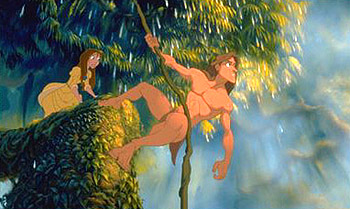
Most people know, or at least know of, the story of Tarzan and Jane. Tarzan, an orphaned Victorian England infant is stranded in the jungle to be raised by apes, after his parents are killed. He learns to live among the animals of the jungle, becoming their friend and protector. However, the arrival of “modern” man into the jungle, exploring their world, brings Tarzan into conflict with those who seek to claim his world as their own. Jane, the daughter of a wealthy explorer from England, befriends, and then falls for, the “ape man”, as he learns about his own humanity and his heritage. The time honoured story, until this film came along, never really hooked me, to be honest. I always felt disconnected with Tarzan in much the same way he felt disconnected with the rest of us. His plight, indeed, the analogous fable-esque qualities of his legend, seemed unimportant and uninteresting. It took the premise of what it takes to be a product of your surroundings and slogged away until there’s nothing left. So I came to see Tarzan as little more than the oft-parodied jungle man, in league with Mowgli for the claim to be king of the jungle.
The old Tarzan films, of which we come to know the eponymous performance of one Johnny Weismuller in the title role, are perhaps the most popular iteration of Edgar Rice Burroughs’ character, although the film and television industries had been working on Tarzan for a while before hand, and ever since. Famous flop Greystoke, directed by Hugh Hudson and starring a dreadfully dreary Christopher Lambert as Tarzan, and Andie MacDowell as Jane, told the “true” story of the character, in as much as it tried to encompass the nuances and detail of the original text material. Bo Derek flopped her norks out in the 1981 debacle, Tarzan The Ape Man, which excited teenage boys and almost nobody else. The fact that film was directed by Bo’s husband probably explained that bizarre creative decision.Then there was the most recent live action version starring Starship Troopers “actor” Casper va Dien, and ingenue actress Jane March (who got Bruce Willis to bare his penis in Color Of Night). Tarzan & The Lost City as a debacle was nothing on the version with Bo Derek, but it still bombed, mainly due to the fact that perhaps people were a little blasé about a character running through the jungle in a loincloth. Was there anything new about Tarzan? That was the question.
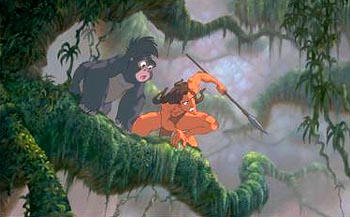
Apparently, the folks at Disney obviously thought so, because in 1999 they delivered one of their best animated films, and one of my favourites. Tarzan, featuring songs performed by Genesis front-man Phil Collins, is a chest-beating adventure that never ceases to entertain. Filled with wonderful characters, some great animation and beautiful music, Tarzan ranks as one of the modern Disney’s best works.
The film opens with a shipwreck, as Tarzan’s parents escape the burning boat to the coastline of Africa, where they set up home to the best of their ability. This back-story to Tarzan’s life, particularly when female ape Kala (voice of Glenn Close) discovers the baby alone in a box after his parents are killed by Sabor, a vicious leapord in the area, is quite poignant. From there, we follow Tarzan through his formative years (voiced as a youngster by Alex D Linz) as he encounters wild elephants, tries to become friends with fellow ape-children, and eventually, win the approval of Kala’s mate Kerchak (voice of Lance Henriksen), who doesn’t want a human growing up in the ape family. It is Tarzan’s inability to gain favour with Kerchak that drives some of the narrative of the film.
As a young man (voiced by Tony Goldwyn), Tarzan encounters visiting explorers Professor Porter (Nigel Hawthorne), his daughter Jane (Minnie Driver) and their guide Clayton (Brian Blessed), who is also apparently an expert hunter. After rescuing Jane from a herd of baboons, he finds that she is like him, a human, and the two form a bond. Jane seeks to educate the primitive Tarzan in the ways of modern man, teaching him to speak English and understand the wider world. This conflicts with Kerchaks orders not to mix with the strangers, since they’re alien to the apes, and possibly dangerous. Tarzan, seeking a link to his own humanity, disagrees and goes against Kerchak, a fact that leads to the ultimate sacrifice by one of the ape group. Clayton, meanwhile, seeks to capture the apes for commercial gain, working against the Professor for his own greed.
Tarzan, in my humble opinion, represents a perfect marriage between images, song and music. The fabulous songs by Phil Collins suit the films tone and style perfectly, enhancing the plot and moving the story forward. The kindred score from Mark Mancina, which takes Collins’ themes and moulds them into the rest of the film so well it’s achingly beatiful, is stunning. Collins’ work on Tarzan rightly won him an Oscar, for “You’ll be In My Heart”, which is the moving love-song for the film. Mancina, backing Collins’ work, won very little, although in my opinion this is singularly his best work on film to date. Both Mancina and Collins would team up again in Brother Bear, however the results on that score were underwhelming by comparison.
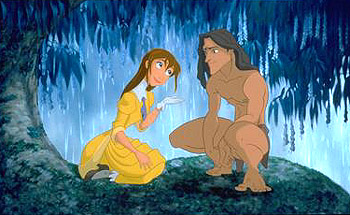
But where the film really strikes a chord with me is the animation. The combination of traditional 2D hand-drawn animation, and the revolutionary “Deep Canvas” process, which is essentially a computer generated background made to look like a traditional 2D background. The Deep Canvas process won the Disney studio a special technical Oscar, and the technology would also be used on follow-up films Atlantis: The Lost Empire, and Treasure Planet. Deep Canvas brought Tarzan’s jungle world to stunning life, the trees and foliage moving in harmony with invisible winds and allowing some truly breathtaking panoramic sequences to be achieved. The animation of Tarzan and Jane, in particular, is tender and nuanced, as they come to grips with their feelings for each other. The action sequences, in particular a bravura series of shots in which Sabor attacks the now grown Tarzan, are stunningly realised, and while sometimes dark and adult oriented, never overwhelm the film like, say, the death of Mufasa in The Lion King. Claytons final battle with Tarzan, swinging high up in the vines, is violent and scary, and should perhaps be monitored by parents of younger children. It’s deadly outcome isn’t overt, but rather cleverly hidden from younger eyes by shadows. Still, perhaps this most violent of outcomes remains a defining moment in the film.
The vocal characterisations, and dialogue itself, is superb. Each cast member inhabits their role, in particular a virginal and innocent Jane being performed by Minnie Driver. Driver’s strength as a vocal performer is vastly underrated, her portrayal of Jane here as a wilful, yet essentially feminine, romantic interest for the male lead. Tony Goldwyn is solid (if somewhat unremarkable as his square-jawed vocal production) as Tarzan, and the pair of them have a great chemistry on screen, albeit in animated film. Brian Blessed, (thankfully a long long way from his performance in The Phantom Menace, as the indecipherable underwater king of the Jar Jars) is resolutely slimy as the vindictive, intelligent hunter Clayton, and it’s this velvet voiced menace that makes the character truly memorable. Glenn Close warbles her way through a rendition of You’ll be In My Heart, and brings the maternal warmth to Tarzan’s ape-mother required to bond with us as an audience. Comedy relief in the film is provided by Rosie O’Donnell (who da thunk it?) as Terk, Tarzan’s self appointed best friend, and Tantor (Wayne Knight), a scardey-cat elephant who looks totally out of place at the ape nest.
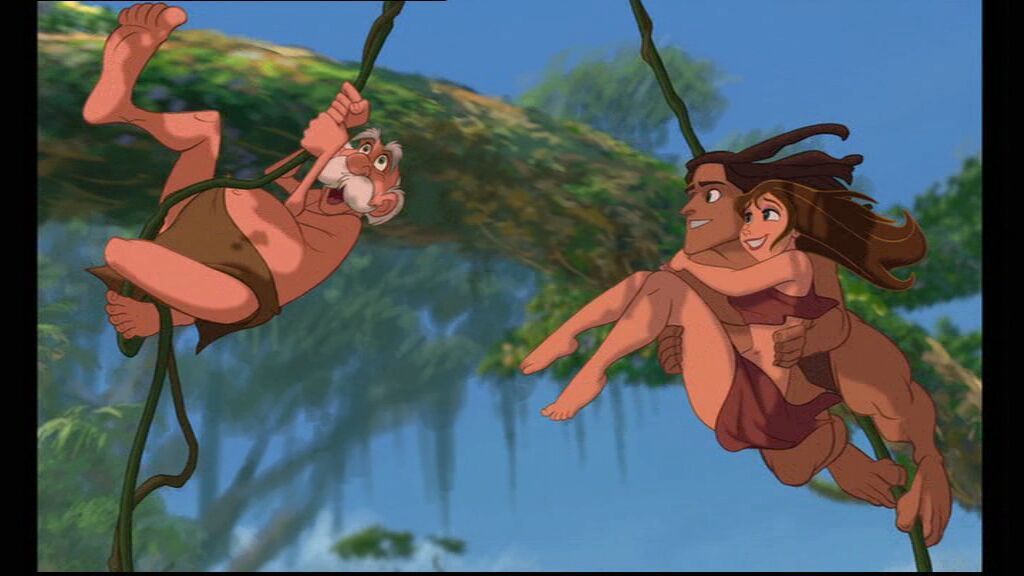
While many Disney fans will stand shoulder to shoulder and battle for supremacy in declaring The Lion King, Aladdin, and perhaps The Little Mermaid as the pinnacle of the studio’s modern renaissance, I would state that perhaps Tarzan, for sheer exuberance and detail, the nuanced storyline and amazing music, is up there as well. Perhaps not as “cool” as The Lion King, but for storytelling perfection, it’s hard to go past the man in the loincloth.

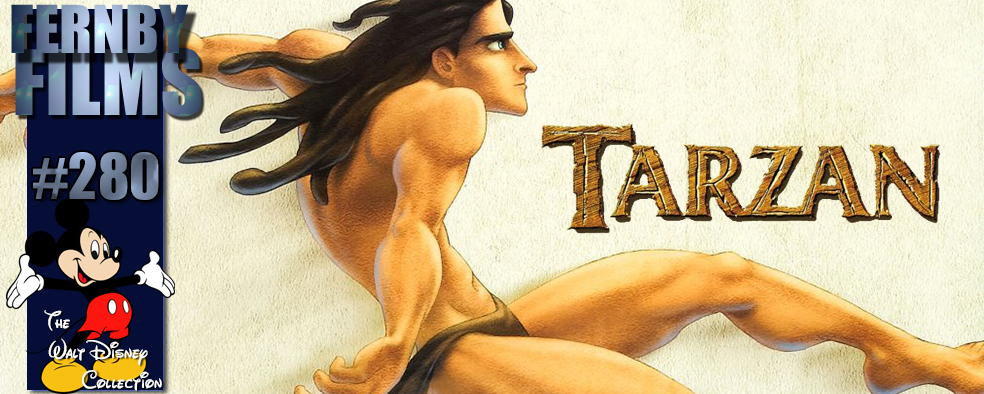









great review, i totally TOTALLY agree with you on what you said in the last paragraph about it being up there with the best. people always overlook tarzan, but when i saw it again after a few years of thinking the lion king was the greatest, i felt like i'd discovered a treasure trove. truly great, in my top 3 favourite disney films (none of which are the lion king).
Thanks for your kind words, Naomi. Glad you re-discovered Tarzan, it truly is a "warm fuzzy" piece of cinema.